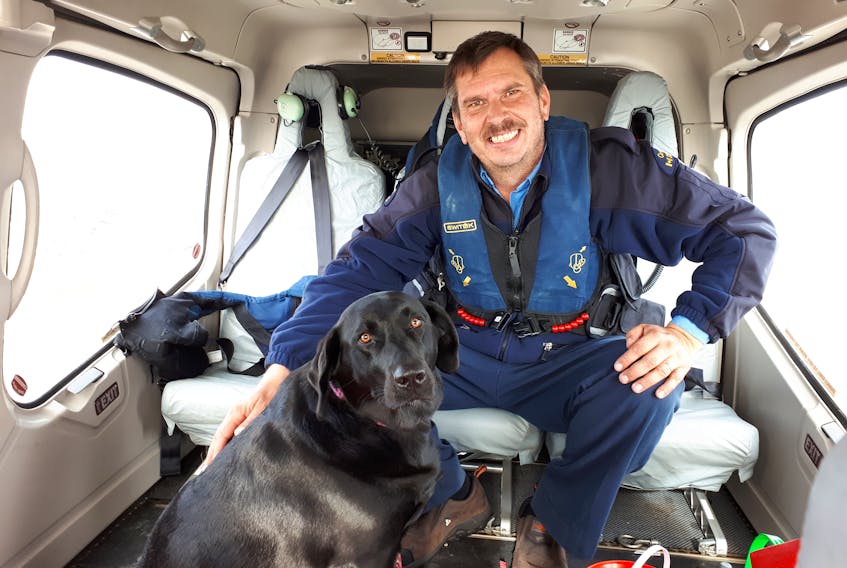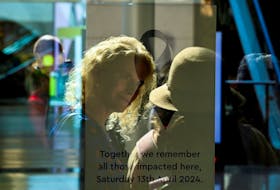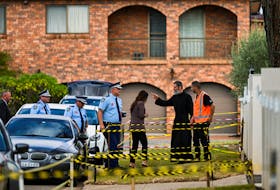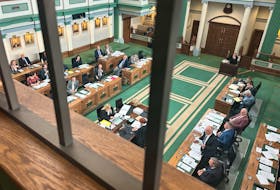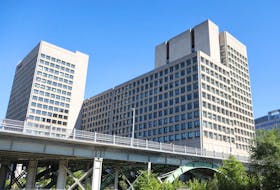PUFFIN ISLAND, N.L.
A helicopter, its blades turning at about 400 revolutions per minute, hovers above the northern shores of Bonavista Bay the morning of Oct. 4.
It’s destination, Puffin Island, one of only five remaining manned remote lighthouses in Newfoundland and Labrador.
It’s cargo, supplies and a turnaround crew for the lighthouse just to the south of Greenspond.

As the small desolate island comes into view, the pilot begins his descent. Less than a kilometre in circumference, its only occupants are the lightkeepers, who have been stationed on the island for 145 years, since the island’s first lighthouse went into operation in 1873.
Finishing up a 28-day shift, principal lightkeeper Craig Burry meets the replacements. He exchanges a few pleasantries and sets to work unloading the supplies, namely drinking water. Apart from rain collection, the island is too small to maintain a fresh water supply.
Once the task is completed, he sets about showing off the lighthouse’s amenities. Leading the charge is Molly, a three-year-old black Labrador retriever Burry calls his “lighthouse dog.”
“They used to keep dogs on the island years ago,” he said as he walked, but Molly always makes the trip back home to Wesleyville. “They’re great companionship.”
As he reaches the power station and pulls the door open, his companion barrels off to the side, frolicking through the grass. The inner workings of a lighthouse are low-priority for Molly, but inside is the heart of the entire operation.
When Burry started in 1993, the entire operation was diesel dependent. While the generator is still in place, green energy – five wind turbines and solar panels feeding a large battery bank – carry the bulk of the lighthouse’s power needs.
“We probably only need the generator for about an hour a day now,” he says.
With everything looking shipshape, Burry heads across the path to the lighthouse. Molly is nearby greeting the new crew.

Daily routine
Burry climbs the metal stairs, as so many times before throughout his 25-year career, and gives the automated lamp a quick inspection.
While the keepers don’t dabble with the electronic component of the lamp, they are responsible for minor repairs, like changing out bulbs.
But it’s just one small aspect of the daily routine. On top of keeping vigil and relaying information to fishermen, the lightkeepers are responsible for maintaining the power supply so the light never fades. This involves constantly inspecting windmills, solar panels, batteries, engine oil and fuel levels, which are documented in daily logs.
Furthermore, the lightkeepers are responsible for the upkeep of the lighthouse facilities, painting and cutting grass, and are trained for emergency response should the worst happen.
However, his job was nearly eliminated back in 2009, after the Canadian Coast Guard looked at removing staffed positions from lighthouses throughout the country.
Crucial
Ultimately, a senate review and intense public backlash staved off the terminations. Release of the report in 2010 indicated the many functions of lighthouse keepers are crucial in maintaining marine safety and sovereignty.
The late Bill Rompkey, who chaired the senate committee, according to CTV News, told reporters, at the time, “We're suggesting that those that are there now stay -- keep the keepers."
And Burry maintains it was the right decision.
“Safety is our number one priority,” he said, noting, having personnel on hand allows for a speedier response.
“How can you put a price on life?” he said.
Continuing the tour, Burry makes his way towards the boat house, where an emergency vessel is ready and waiting.

Keeping busy
Along the path, he points a finger to fencing that has long dried out and faded, remnants of the time he tried to establish a root vegetable garden during his spare time.
“Field mice kept destroying it, so I had no other choice but to give up on it,” he said.
But keeping busy during idle time is the key to it all, he said.
While Puffin Island maintains two lightkeepers to a shift, and he has Molly at his side, life as a lightkeeper is lonely work, especially when there’s a wife and two children back home.
“It’s hard,” he says about being away. “Don’t get me wrong, I love my job, but it always seems like you’re missing something important, family events and get togethers.
“But it’s goes with the job and you learn to live with it.”
While technological advancements have threatened his job, Burry sees some merit in modernization, as it’s allowed him to keep constant contact with his family – with internet and cellphone service to bridge the gap. There’s even satellite television to keep abreast of the latest happenings and world events. A big step up from his early years, back when there was only a two-in-one fax machine/telephone.
- Lighthouses in Canada
- The first lighthouse in Canada was established at Louisbourg on Cape Breton Island, Nova Scotia, in 1734.
- In 1970, the coast guard began the process of systematically automating lightstations and removing staff from them.
- Technological developments in lighthouse equipment had made it possible to operate the lights and to activate foghorns without immediate human attention.
- In British Columbia and Newfoundland and Labrador, public pressure effectively stopped the removal of lightkeepers in 1998.
- At remote locations, helicopters and vessels are used to resupply lightstations and move lightkeepers, which contributes to higher maintenance costs.
- Of the 50 staffed facilities in the two regions, 29 are located at remote sites that have no year -round road access.
- In the Newfoundland and Labrador region, 18 of the 23 staffed stations can be reached by road. Five are in remote locations: Puffin Island, Green Island (Trinity Bay), Green Island (Fortune Bay), Pass Island and Cape Race.
- All 23 staffed lightstations are equipped with solarized equipment, most are powered by hydro, and several have wind turbines and solar power or a combination of the two.
- Three of the five remote sites have backup diesel power for the lightkeepers.
- At the five remote sites, a rotational system based on 28-day shifts is used. Two people per shift work 28 continuous days and are replaced by two new keepers for the next 28-day period. The system requires four lightkeepers per station. Because of remoteness, relief keepers are required to replace absent keepers.
- Estimated total operational costs of the agency’s staffed lighthouse program to be $11.5 million in 2008 – Newfoundland and Labrador region accounted for $3.2 million.
Source: SEEING THE LIGHT: REPORT ON STAFFED LIGHTHOUSES IN NEWFOUNDLAND AND LABRADOR AND BRITISH COLUMBIA
But ultimately his saving grace, during down time, has been his hobbies. To keep his hands from becoming idle, he builds Coast Guard ship replicas, model lighthouses, and his latest creation, a dartboard case.
“There’s not too much I haven’t tried, to tell you the truth,” he said.
With everything on an even keel and the new crew settled in, Burry says his good-byes and heads for the chopper to spend four weeks with his family.
Nearing the helipad, he gives the call and Molly comes tumbling through the grass — one last inspection of the island before their turnaround starts — climbs the steps and jumps aboard.
Pulling away from Puffin Island the two look out the window to the lighthouse below. There’s no words coming through Burry’s intercom, but the look says it all – “See you again in 28 days.”

